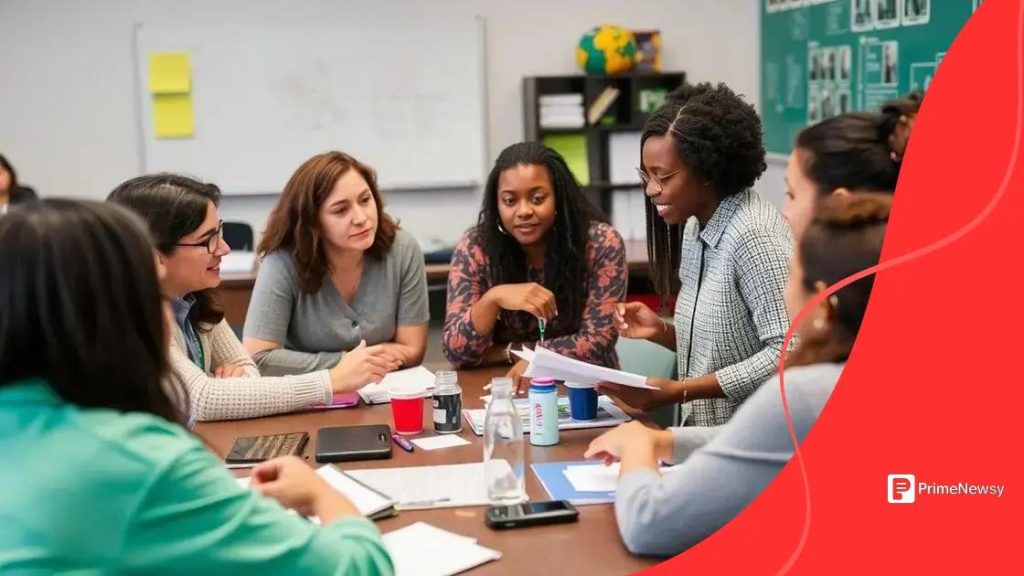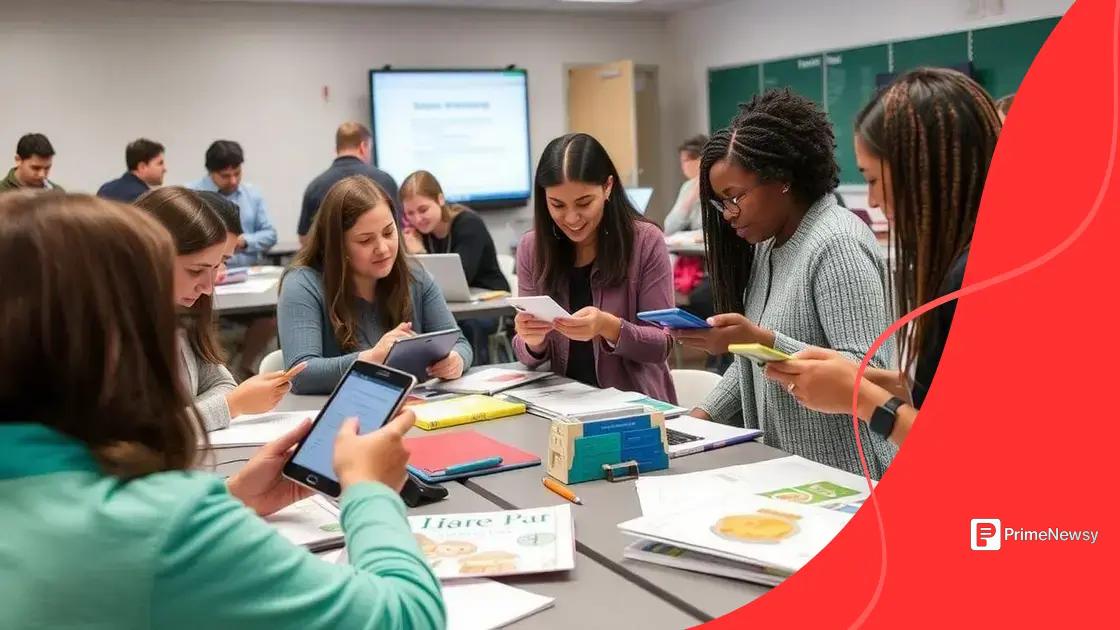Teacher professional development: unlocking impactful growth

Anúncios
Creating a culture of continuous learning in schools involves fostering collaboration among educators, providing ongoing professional development, and encouraging student engagement to enhance educational outcomes.
Teacher professional development is essential not only for educators but also for the students they guide. Have you ever wondered how continuous learning can transform teaching practices and enrich the classroom experience? Let’s dive into the innovative strategies that are shaping the future of education.
Anúncios
Understanding the importance of teacher professional development
Understanding the significance of teacher professional development is key in shaping successful educational environments. When teachers engage in ongoing learning, they not only enhance their own skills but also positively affect their students’ achievements.
The role of professional development
Professional development equips teachers with new strategies and techniques that can transform their teaching practices. This is essential in a rapidly changing educational landscape where new methods and technologies are constantly emerging.
- Improved teaching practices
- Enhanced student engagement
- Increased educational standards
- Collaboration among educators
Furthermore, professional development fosters a culture of improvement and collaboration among staff. It encourages teachers to share their experiences and learn from one another, leading to a more cohesive learning community. When teachers collaborate, they often develop more effective practices that directly impact student learning.
Anúncios
Benefits for students
Students benefit immensely from the enhanced knowledge and skills their teachers acquire through professional development. Teachers who continue to learn are more likely to implement innovative teaching strategies that cater to diverse learning needs. This is crucial for creating inclusive classrooms where all students have the opportunity to succeed.
Additionally, when teachers are confident in their skills, they can provide a better learning environment. For example, they may introduce new technologies, engage students through project-based learning, or utilize data-driven instruction to tailor their approaches to meet student needs.
Importance of ongoing training
In today’s educational context, ongoing training is not just beneficial; it is essential. Educators must stay current with the latest research and techniques to ensure they can provide high-quality instruction. This ongoing education shapes how teachers interact with their students and adapt to new challenges.
Ultimately, investing in teacher professional development is investing in the future of education. When schools support their teachers with robust training programs, they create an environment where both educators and students can thrive.
Key benefits of ongoing training for educators
Ongoing training for educators is vital for ensuring that teaching practices remain effective and relevant. Through continuous learning, teachers gain new insights and abilities that enhance their classrooms.
Adapting to change
The world of education is always evolving, with new technologies and teaching strategies emerging regularly. Ongoing training helps teachers adapt to these changes, ensuring they can meet the needs of their students. This adaptability leads to a more dynamic learning environment.
- Access to the latest educational research
- Opportunities to learn new technologies
- Strategies for addressing diverse student needs
- Collaboration with peers to share best practices
This training not only benefits the teachers but also greatly impacts students. Educators who are well-prepared can engage students more effectively and tailor their instruction to support individual learning styles. When teachers apply what they learn from training, they often see improved student outcomes.
Building professional networks
Another key benefit of ongoing training is the opportunity for educators to build professional networks. Networking allows teachers to connect with colleagues, share ideas, and access a broader range of resources. These connections can inspire new methods of teaching and learning.
Moreover, participating in training programs can lead to mentoring opportunities. Experienced educators can guide newer teachers, creating a supportive community. This nurturing environment fosters collaboration and growth, helping everyone involved to thrive.
Enhancing job satisfaction
Lastly, ongoing training contributes to higher job satisfaction among educators. When teachers feel competent and confident in their skills, they are generally happier at work. This happiness translates to a positive classroom atmosphere, benefiting both teachers and students alike.
Furthermore, as educators continue to develop professionally, they can take on leadership roles within their schools. This progression not only boosts their careers but also enriches the educational community.
Innovative strategies for effective teacher workshops

Innovative strategies for effective teacher workshops can transform the way educators engage with professional development. These approaches focus on making learning practical and relevant to everyday teaching.
Interactive Learning Experiences
One key strategy is to create interactive learning experiences. Instead of traditional lectures, workshops can include hands-on activities that encourage collaboration among teachers. When educators participate in role-playing or group discussions, they can better understand how to apply new concepts in their classrooms.
- Use of simulations and role-playing
- Collaborative problem-solving sessions
- Workshops that emphasize peer teaching
- Hands-on technology integration
This active engagement helps teachers retain information and feel more confident in implementing new skills. Additionally, they can share insights and strategies with one another, fostering a sense of community.
Leveraging Technology
Another innovative approach is leveraging technology during workshops. Online platforms can facilitate blended learning experiences, allowing teachers to access resources before, during, and after the training. For example, a pre-workshop video can introduce key concepts, while real-time polling apps can gather feedback during sessions.
With the integration of technology, workshops can be more flexible and tailored to individual learning needs. This not only enriches the training experience but also encourages teachers to incorporate similar tools into their own classrooms.
Focus on Practical Application
It’s crucial that workshops emphasize practical application. Educators benefit when they can connect new strategies to their current curriculum and classroom challenges. Providing time for teachers to plan how to implement new ideas ensures that learning is actionable.
Moreover, having follow-up sessions or coaching can support the application of these strategies over time. This ongoing support reinforces learning and encourages sustained change in teaching practices.
Measuring the impact of professional development programs
Measuring the impact of professional development programs is essential to understand their effectiveness and improve future offerings. By analyzing various outcomes, schools can determine how these programs benefit educators and students alike.
Data Collection Methods
One effective way to measure impact is through various data collection methods. Surveys and feedback forms can provide teachers with the opportunity to express their thoughts on the training they received. These insights help identify strengths and areas for improvement.
- Pre- and post-training assessments
- Teacher surveys on perceived effectiveness
- Student performance data
- Classroom observations to assess changes in teaching practices
Additionally, schools can track teacher retention rates and student outcomes over time. Such data can reveal long-term benefits, helping to inform further program development.
Analyzing Student Outcomes
Another critical aspect of measuring impact is analyzing student outcomes. When teachers implement what they learn during professional development, students often experience improved academic performance. By examining test scores, engagement levels, and overall satisfaction, educators can gain a clearer picture of the effectiveness of these programs.
Furthermore, qualitative data, such as student feedback, can provide valuable insights into how training affects the classroom dynamic. For example, if students report feeling more engaged or supported, it is likely that their teachers have successfully applied new teaching strategies.
Continuous Improvement
For a professional development program to be truly effective, it must promote continuous improvement. Regularly reviewing and analyzing data ensures that the training remains relevant and beneficial. Schools should schedule repeat assessments and adapt programs based on findings.
This ongoing evaluation process not only enhances the quality of professional development but also strengthens the entire educational community. As teachers grow and evolve, they contribute to a more effective and positive learning environment for students.
Creating a culture of continuous learning in schools
Creating a culture of continuous learning in schools is essential for both teachers and students. This culture fosters an environment where everyone feels motivated to grow and adapt.
Importance of Collaboration
Collaboration among educators is a cornerstone of a learning culture. When teachers work together, they share ideas, resources, and experiences. This not only enhances their teaching practices but also leads to a supportive community.
- Regular team meetings to discuss goals
- Peer observations to learn from each other
- Mentorship programs for new teachers
- Sharing successes and challenges collaboratively
By fostering collaboration, schools can create a safe space for teachers to experiment with new strategies and approaches without fear of failure. This encourages everyone to strive for excellence.
Providing Ongoing Professional Development
Another key element in building a culture of continuous learning is offering ongoing professional development. Schools should provide various training opportunities that are relevant to teachers’ needs. Options could include workshops, online courses, or conferences.
When educators have access to these resources, they are more likely to integrate new concepts into their teaching. This growth mindset is crucial for fostering a resilient educational environment. It encourages teachers to stay updated with the latest research and practices.
Encouraging Student Engagement
A culture of continuous learning also extends to students. When they see their teachers engaging in learning, they are inspired to do the same. Schools can promote student engagement by fostering curiosity and creativity.
Project-based learning and inquiry-based approaches help students take ownership of their learning. This creates a dynamic classroom environment where students feel empowered to explore and discover.
Additionally, recognizing and celebrating learning achievements, whether large or small, reinforces the importance of continuous growth. Moreover, involving parents and the community in the learning process creates a support system that enhances the educational experience for all.
FAQ – Questions about creating a culture of continuous learning in schools
What is a culture of continuous learning?
A culture of continuous learning is an environment where educators and students alike are encouraged to grow, adapt, and engage in ongoing training and development.
How can collaboration among teachers benefit students?
Collaboration allows teachers to share resources and strategies, leading to improved teaching practices, which ultimately enhances student learning outcomes.
Why is ongoing professional development important for educators?
Ongoing professional development helps educators stay updated with the latest teaching methods and practices, ensuring they can effectively meet their students’ needs.
How can students be encouraged to take ownership of their learning?
By incorporating project-based learning and inquiry-based approaches, students feel empowered to explore topics that interest them, fostering a sense of ownership in their education.